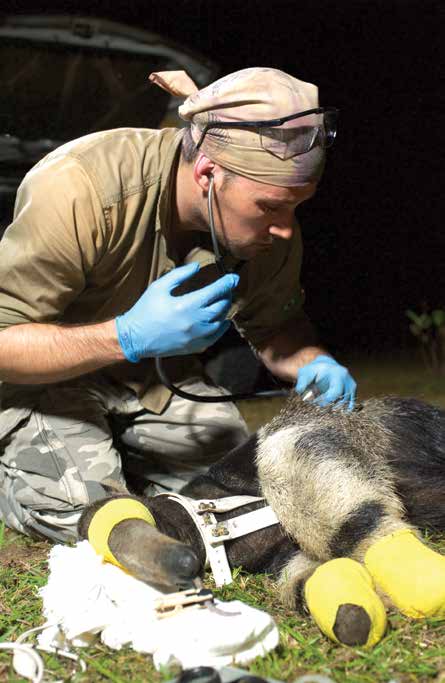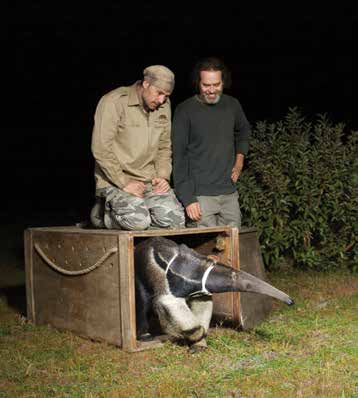SOUTH AMERICA’S RARE SOUTH AMERICA’S GIANTS CONTINUE TO SURPRISE
by Tim L. Tetzlaff
Naples Zoo Director of Conservation
Like innocents arriving through a portal from the Pleistocene past, South America’s giant armadillos and giant anteaters naively wander a gauntlet of modern dangers. To give voice to these quiet creatures, a team of conservationists led by Dr. Arnaud Desbiez and supported by zoos continues to raise awareness as they answer foundational questions that just may let these creatures survive in the today’s Anthropocene age. Their efforts were recently rewarded with discovering a new baby giant armadillo as well as the chance to solve one of the gravest threats to giant anteaters.

Head Veterinarian Danilo Kluyber monioring a giant anteater during a medical exam. This giant anteater and others will be part of a new four-year study called Anteaters & Highways. The goal is to help save
this species from dying on the roads. Photo Credit: © Fergus Gill/Maramedia
GIANT NEWS
A far cry from their diminutive nine-banded armadillo cousins in the United States, giant armadillos weigh up to 50 kg (110 lbs.) and measure up to 1.5 m (5 ft.) long with impressive claws that can reach over 20 cm (8 in.). Little was known of these creatures until Desbiez created the Giant Armadillo Project in Brazil in 2010. Even most locals in their range had never seen one. While studying these nocturnal creatures, the team had the opportunity to observe challenges facing other species and has recently expanded their team to launch a new project to address the shockingly deadly threat of roadkill: Anteaters & Highways.
HELPING GIANTS ON THE MOVE
While listed by the IUCN as Vulnerable to extinction across its range, the giant anteater is already extinct in several former range countries and some Brazilian states.
During a preliminary study by the team, over 1000 km (621 miles) of paved highway in the Brazilian state of Mato Grosso do Sul were monitored twice a month for a year. The results were shocking with 136 giant anteaters found among the carcasses. The tight focus of the Anteaters & Highways project is to reduce this deadly threat.
GPS harnesses placed on giant anteaters in the Pantanal by the team have already revealed the challenge will be substantial as preliminary analysis indicate their home ranges are larger than what is currently published. Their new four year study aims to address the threat by collecting data on why, when, and how anteaters interact with roadways in the more developed Cerrado ecoregion.
Research results will provide insight into movement patterns to inform road management strategies and help save this iconic species.
ZOO SUPPORT
The core costs of Anteaters & Highways are covered by a multi-year grant from Fondation Segré. Additional support comes from zoos across North America and Europe that can be seen on the project’s website. “Few people realize how engaged zoos are in species conservation throughout the world,” explains Deszbiez, who is himself employed by the Royal Zoological Society of Scotland.
“Whether it is to review an anesthetic protocol, discuss a particular behavior, review a paper we wrote, give advice on equipment or even help develop a fundraising strategy, advice from zoo professionals is very much appreciated and most often fundamental. This is certainly something we use and abuse as much as we can. It is amazing how generous people working in zoos are with their time and expertise.”
Among those supporters is Naples Zoo who recently provided funding for the project’s head veterinarian through ZCOG, an organization that provides logistical and fundraising support for New
World conservation efforts.
“The Naples Zoo has been a long term partner of the Giant Armadillo Conservation Project for many years from providing funding for harnesses to monitor giant anteaters to setting up and managing a website to promote our work,” Desbiez said. “The new funding from the Zoo to support the head veterinarian of the project Danilo Kluyber is a real game changer for us. Knowing funding for this position is secure we can better concentrate our efforts and time to our conservation work.”

Head Veterinarian Danilo Kluyber (left) and Dr. Arnaud Desbiez monitor a giant anteater returning to its home following a medical exam and placement of GPS harness as part of the Anteaters & Highways research project to save this iconic species. Photo Credit: © Jason Woolgar
A BABY ARMADILLO NAMED TIM
Perhaps nothing speaks of survival and hope like a new baby. The team is thrilled to report a giant armadillo named Isabelle has given birth. I was profoundly honored when the team named the baby Tim after me. Isabelle and the Giant Armadillo Project made global headlines in 2013 when they first documented the breeding of this highly elusive species and began studying Isabelle’s male offspring, Alex. Over the next two years, Isabelle slowly revealed giant armadillo secrets from an updated gestation period of five months to providing much more extensive maternal care than previously expected. Those continuing discoveries ended when Alex died from injuries most likely given by a puma. It was a devastating loss for the team – emotionally and scientifically. The discovery of Tim and the video of mother and son was great news for the project. (see http://napleszoo.org/conservationprograms/giant-anteaters)
RESETTING THE DISCOVERY CLOCK
And while the team must wait two years to catch up to where Alex left off, Tim’s arrival has already added key data for the species: a three-year birth interval. That indicates a slower population growth rate than once hypothesized – meaning reversing their population decline will take even longer. For perspective, an African elephant with a 22-month gestation has an average birth interval just over four years. This is the third baby the team has documented with Isabelle. Being able to record events like this demonstrates the importance of long-term projects and provides ample evidence for the team receiving the prestigious Whitley Award.
With cooperation between passionate field conservationists and dedicated partners like these, South America’s wildlife wonders may just have that chance at a brighter future.
Far from the simple menageries of the past, today’s nationally
accredited zoos are centers of learning and natural crossroads for
biologists, educators, environmental scientists, and researchers –
as well as for students, conservationists, and all animal lovers.
Naples Zoo at Caribbean Gardens is an award-winning,
private 501(c)(3) nonprofit serving wildlife and families here
and around the world. More information at www.napleszoo.org.




Leave a Reply
Want to join the discussion?Feel free to contribute!